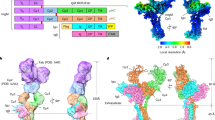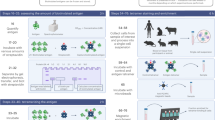Abstract
B lymphocytes are activated by many different antigens to produce specific antibodies protecting higher organisms from infection. To detect its cognate antigen, each B cell contains up to 120,000 B-cell antigen receptor (BCR) complexes on its cell surface. How these abundant receptors stay silent on resting B cells and how they can be activated by a molecularly diverse set of ligands is poorly understood1. Here we show, with the use of a quantitative bifluorescence complementation assay (BiFC)2,3, that the BCR has an intrinsic ability to form oligomers on the surface of living cells. A BCR mutant that fails to form oligomers is more active and cannot be expressed stably on the B-cell surface, whereas BiFC-stabilized BCR oligomers are less active and more strongly expressed on the surface. We propose that oligomers are the autoinhibited form of the BCR and that it is the shift from closed BCR oligomers to clustered monomers that drives B-cell activation in a way that is independent of the structural input from the antigen.
This is a preview of subscription content, access via your institution
Access options
Subscribe to this journal
Receive 51 print issues and online access
$199.00 per year
only $3.90 per issue
Buy this article
- Purchase on Springer Link
- Instant access to full article PDF
Prices may be subject to local taxes which are calculated during checkout




Similar content being viewed by others
References
Reth, M. Oligomeric antigen receptors: a new view on signaling for the selection of lymphocytes. Trends Immunol. 22, 356–360 (2001)
Kerppola, T. K. Bimolecular fluorescence complementation (BiFC) analysis as a probe of protein interactions in living cells. Annu. Rev. Biophys. 37, 465–487 (2008)
Hu, C.-D., Chinenov, Y. & Kerppola, T. K. Visualization of interactions among bZIP and Rel family proteins in living cells using bimolecular fluorescence complementation. Mol. Cell 9, 789–798 (2002)
Venkitaraman, A. R., Williams, G. T., Dariavach, P. & Neuberger, M. S. The B-cell antigen receptor of the five immunoglobulin classes. Nature 352, 777–781 (1991)
Engels, N., Engelke, M. & Wienands, J. Conformational plasticity and navigation of signaling proteins in antigen-activated B lymphocytes. Adv. Immunol. 97, 251–281 (2008)
Schamel, W. W. & Reth, M. Monomeric and oligomeric complexes of the B cell antigen receptor. Immunity 13, 5–14 (2000)
Tolar, P., Sohn, H. W. & Pierce, S. K. The initiation of antigen-induced B cell antigen receptor signaling viewed in living cells by fluorescence resonance energy transfer. Nature Immunol. 6, 1168–1176 (2005)
Tolar, P., Sohn, H. W. & Pierce, S. K. Viewing the antigen-induced initiation of B-cell activation in living cells. Immunol. Rev. 221, 64–76 (2008)
Rolli, V. et al. Amplification of B cell antigen receptor signaling by a Syk/ITAM positive feedback loop. Mol. Cell 10, 1057–1069 (2002)
Schrum, A. G. et al. High-sensitivity detection and quantitative analysis of native protein–protein interactions and multiprotein complexes by flow cytometry. Sci. STKE 2007, pl2 (2007)
Hu, C.-D. & Kerppola, T. K. Simultaneous visualization of multiple protein interactions in living cells using multicolor fluorescence complementation analysis. Nature Biotechnol. 21, 539–545 (2003)
Siegers, G. M. et al. Identification of disulfide bonds in the Ig-α/Ig-β component of the B cell antigen receptor using the Drosophila S2 cell reconstitution system. Int. Immunol. 18, 1385–1396 (2006)
Minguet, S., Swamy, M., Alarcon, B., Luescher, I. F. & Schamel, W. W. Full activation of the T cell receptor requires both clustering and conformational changes at CD3. Immunity 26, 43–54 (2007)
Gil, D., Schamel, W. W. A., Montoya, M., Sánchez-Madrid, F. & Alarcón, B. Recruitment of Nck by CD3 epsilon reveals a ligand-induced conformational change essential for T cell receptor signaling and synapse formation. Cell 109, 901–912 (2002)
Meixlsperger, S. et al. Conventional light chains inhibit the autonomous signaling capacity of the B cell receptor. Immunity 26, 323–333 (2007)
Schamel, W. W. et al. Coexistence of multivalent and monovalent TCRs explains high sensitivity and wide range of response. J. Exp. Med. 202, 493–503 (2005)
Lillemeier, B. F. et al. TCR and Lat are expressed on separate protein islands on T cell membranes and concatenate during activation. Nature Immunol. 11, 90–96 (2010)
Kim, J.-H., Cramer, L., Mueller, H., Wilson, B. & Vilen, B. J. Independent trafficking of Ig-α/Ig-β and μ-heavy chain is facilitated by dissociation of the B cell antigen receptor complex. J. Immunol. 175, 147–154 (2005)
Treanor, B. et al. The membrane skeleton controls diffusion dynamics and signaling through the B cell receptor. Immunity 32, 187–199 (2010)
Monroe, J. G. ITAM-mediated tonic signalling through pre-BCR and BCR complexes. Nature Rev. Immunol. 6, 283–294 (2006)
Kraus, M., Alimzhanov, M. B., Rajewsky, N. & Rajewsky, K. Survival of resting mature B lymphocytes depends on BCR signaling via the Igα/β heterodimer. Cell 117, 787–800 (2004)
Kim, Y.-M. et al. Monovalent ligation of the B cell receptor induces receptor activation but fails to promote antigen presentation. Proc. Natl Acad. Sci. USA 103, 3327–3332 (2006)
Harwood, N. E. & Batista, F. D. New insights into the early molecular events underlying B cell activation. Immunity 28, 609–619 (2008)
Semichon, M., Merle-Béral, H., Lang, V. & Bismuth, G. Normal Syk protein level but abnormal tyrosine phosphorylation in B-CLL cells. Leukemia 11, 1921–1928 (1997)
Pugh-Bernard, A. E. & Cambier, J. C. B cell receptor signaling in human systemic lupus erythematosus. Curr. Opin. Rheumatol. 18, 451–455 (2006)
Peng, S. L. Altered T and B lymphocyte signaling pathways in lupus. Autoimmun. Rev. 8, 179–183 (2009)
Payelle-Brogard, B., Magnac, C., Alcover, A., Roux, P. & Dighiero, G. Defective assembly of the B-cell receptor chains accounts for its low expression in B-chronic lymphocytic leukaemia. Br. J. Haematol. 118, 976–985 (2002)
Lankester, A. C., Schijndel, G. M., Pakker, N. G., Van Oers, R. H. & van Lier, R. A. Antigen receptor function in chronic lymphocytic leukemia B cells. Leuk. Lymphoma 24, 27–33 (1996)
Kawauchi, K., Ogasawara, T. & Yasuyama, M. Activation of extracellular signal-regulated kinase through B-cell antigen receptor in B-cell chronic lymphocytic leukemia. Int. J. Hematol. 75, 508–513 (2002)
Chiorazzi, N. & Ferrarini, M. B cell chronic lymphocytic leukemia: lessons learned from studies of the B cell antigen receptor. Annu. Rev. Immunol. 21, 841–894 (2003)
Storch, B., Meixlsperger, S. & Jumaa, H. The Ig-α ITAM is required for efficient differentiation but not proliferation of pre-B cells. Eur. J. Immunol. 37, 252–260 (2007)
Acknowledgements
We thank L. Leclercq, P. Nielsen, H. Jumaa and W. Schamel for critical reading of this manuscript. This study was supported by the Excellence Initiative of the German Federal and State Governments (EXC 294), by the Deutsche Forschungsgemeinschaft through SFB746 and by the FRISYS programme.
Author information
Authors and Affiliations
Contributions
All experiments were planned by M.R. and J.Y. and conducted by J.Y. The manuscript was prepared by M.R. with J.Y.
Corresponding author
Ethics declarations
Competing interests
The authors declare no competing financial interests.
Supplementary information
Supplementary Figures
This file contains Supplementary Figures 1-12 with legends. (PDF 2048 kb)
Rights and permissions
About this article
Cite this article
Yang, J., Reth, M. Oligomeric organization of the B-cell antigen receptor on resting cells. Nature 467, 465–469 (2010). https://doi.org/10.1038/nature09357
Received:
Accepted:
Published:
Issue Date:
DOI: https://doi.org/10.1038/nature09357
This article is cited by
-
Membrane organization by tetraspanins and galectins shapes lymphocyte function
Nature Reviews Immunology (2024)
-
Antigen footprint governs activation of the B cell receptor
Nature Communications (2023)
-
Impact of oligomerization on the allergenicity of allergens
Clinical and Molecular Allergy (2022)
-
A structural platform for B cell receptor signaling
Cell Research (2022)
-
A specific hybridisation internalisation probe (SHIP) enables precise live-cell and super-resolution imaging of internalized cargo
Scientific Reports (2022)
Comments
By submitting a comment you agree to abide by our Terms and Community Guidelines. If you find something abusive or that does not comply with our terms or guidelines please flag it as inappropriate.



